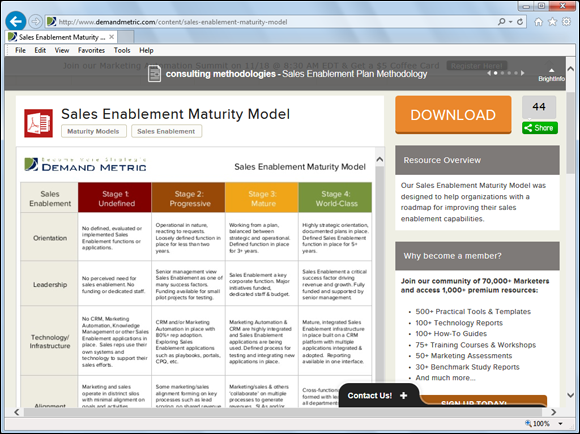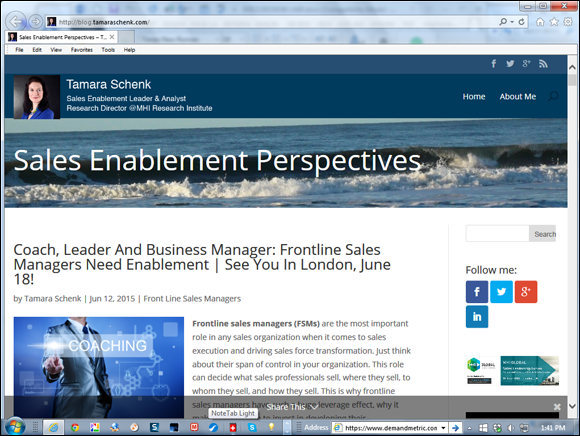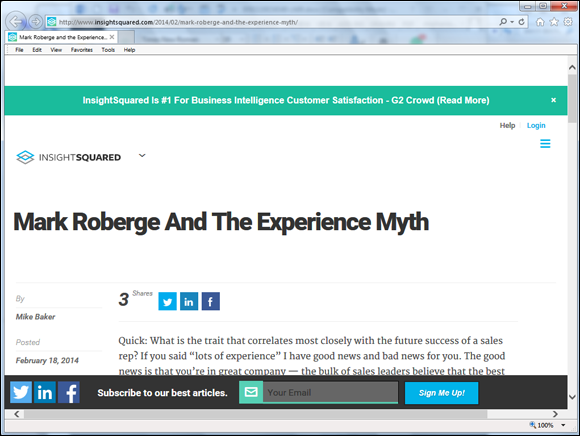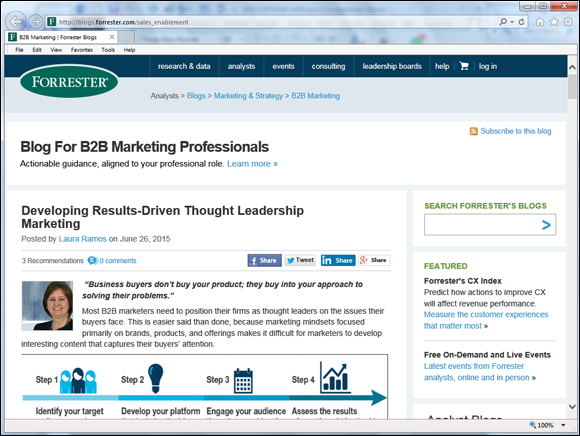Chapter 4
Embracing Sales Enablement
IN THIS CHAPTER
 Learning where your company fits on the maturity scale
Learning where your company fits on the maturity scale
 Considering the evolving role of sales reps
Considering the evolving role of sales reps
 Accommodating the needs of salespeople
Accommodating the needs of salespeople
 Improving the sales coaching process
Improving the sales coaching process
Sales Enablement (SE) focuses on the processes, tools, and techniques companies use to increase the effectiveness of their salesforce and includes marketing automation, digital asset management, CRM systems, and social media monitoring tools.
Of course, the idea of creating sales content to improve sales is not new. Companies have struggled with getting their products into the hands of their customers for centuries. In the early 1900s, the Jell-O Company had its salespeople distribute free Jell-O recipe cookbooks to customers to show how to use Jell-O with their favorite dishes. It’s recorded that more than 15 million cookbooks were distributed in some years and the sales of Jell-O doubled over time.
What is new is the use of the web to assist salespeople in getting the right information to the customer at the right time from anywhere in the world. This chapterlooks at the adoption of SE and the ways in which you can deploy it to help your sales reps hit a home run every time.
Discovering Sales Enablement
When you look at the world of SE, you quickly discover that it means different things to different companies. And some companies take an informal approach whereas others set up rigorous systems that impact every part of their organization. It depends on the size and needs of each company.
The definition of SE that fits the largest possible audience is Doug Winter’s definition in the Business Journals. He writes, “… sales enablement is the ability, by any sales rep, to systematically deliver a personalized, one-on-one customer experience.” Just as in the Jell-O selling days, salespeople need to deliver targeted sales information right into the hands of the buyers. Today, companies reach those buyers via their mobile phones, tablets, or laptops. But the problem remains the same: “One size fits all” never does. The key to effective selling is the ability to present a personalized experience directly to each buyer.
So what essential elements must be present to make an SE system effective? Although several features make up a world-class system, three components are critical:
- Data analytics: These analytics collect and use data to make decisions about what the customer wants so that the sales cycle can be completed quickly. Your SE system must give you the ability to see what customers download, look at, and ask about so that you know what they care about.
- A CRM system: This system provides integration with current customer information to help speed the sales response at each point during the buyer journey.
- A cloud-based content database: Both sales reps and customers need to have the latest content and product updates available to them from anywhere. Your competitors will.
Gaining a competitive advantage
Managers who are presented with the concept of SE need to be convinced that making the effort to implement a new strategy is worth the time and money that’s required. Will it actually improve the win rate? Can it provide a competitive advantage? Answering these questions is key.
So what are the reasons to implement a sales enablement strategy? Some benefits include:
- Making sales reps more responsive to the specific needs of the customer, giving the company a competitive advantage
- Increasing demand by strategically deploying the type of content that potential customers are looking for before engaging a salesperson
- Speeding up the time to complete a sale by answering all the questions customers have whenever they have them
- Keeping all the salespeople up-to-date and aware of changes to products and services
- Assisting sales coaches to meet the individual needs of all sales reps by analyzing their data
- Helping reps gain traction early in their tenure by giving them access to the training they require when and where they need it
These are very desirable outcomes of a sales enablement system. Any manager would love to be able to show results like these to his company’s executives. Unfortunately, making them happen takes a lot of strategizing and experimenting, which is covered in Book 2, Chapter 3.
Evaluating your current status
To begin considering your own SE, it’s helpful to determine where your organization stands on the SE continuum. Demand Metric, a marketing and research firm (see Figure 4-1), uses a model it developed called the “Sales Enablement Maturity Model.” You can download it at http://www.demandmetric.com/content/sales-enablement-maturity-model.

FIGURE 4-1: The Sales Enablement Maturity Model by Demand Metric.
Look at the descriptions of the stages of maturity to determine where your company is right now. Note that the relationship of sales to marketing is an important component. Table 4-1 describes the levels.
TABLE 4-1 The Stages of Maturity in Sales Enablement Strategy
|
Maturity Level |
What’s Happening |
|
Undefined |
No sales enablement activity or perceived need. No structure or operational tools in place. Sales and marketing departments are siloed with no collaboration. Win rate is less than ten percent. (When a company is organized into silos, it means that each department is independent and does not know what the other departments are doing. There is no collaboration.) |
|
Progressive |
You’re in the early days of a loose system (fewer than two years). Requests are made for sales enablement function. Some light response has been received. Sales and marketing departments are aware of each other’s activities and have some coordination. Win rate is 10 to 20 percent. |
|
Mature |
A system has been in place for more than three years. A budget and staff are allocated. There is integration of both automation and a CRM system. Sales and marketing have mutual goals. Win rate is 20 percent. |
|
World Class |
The system has been in place for more than five years. A strategic plan is in place, and sales and marketing work hand in hand with shared revenue responsibilities. Win rate is more than 25 percent. |
Do you recognize your company in one of these descriptions? You’re unlikely to be at the world-class level. Don’t feel frustrated; so few companies are. It’s a slow process. You can, however, move the process forward by identifying your company’s stage of maturity to help focus your efforts and learn what is possible. You also want to consider what goes into making your organization world class in SE.
Tamara Schenk is Research Director of the MHI Research Institute. Her blog is shown in Figure 4-2 (http://blog.tamaraschenk.com/). In her SlideShare presentation, she says that four pillars drive world-class sales enablement (http://bit.ly/1JeWFG7).

FIGURE 4-2: Tamara Schenk’s blog.
Consider whether your company can implement these pillars. The four sales enablement success pillars are as follows:
- Design: Have the customer at the core of your strategy. In today’s marketplace you need the customer at the center of all your marketing efforts. This includes the design of all your owned media like websites and blogs. If your website is hard to navigate or find something, then you need a redesign. Customers aren’t as forgiving about this as they were when the web was new. Their expectations are high, and you need to meet them.
- Scope: Integrate frontline sales managers. This means that your frontline sales managers need to have a way to get feedback from every customer-facing employee. They need to know what’s going on in real time.
- Foundation: Have a foundation in sales operations. All your sales content and training need to support the sales structure as a whole. This framework will ensure that your salesforce gets the right type of training when salespeople need it.
- Collaboration: Collaborate to integrate your company services. If you have siloed departments, you know that you’re preventing people from doing their best work. Interaction and shared responsibilities make your teams successful.
Understanding the new role of sales reps
The role of the sales rep continues to evolve. All the positive value that the web provides also brings with it some obvious negatives — with the main one being that the salesperson is no longer in control of the sales process. In contrast to previous years, salespeople don’t control the narrative these days.
According to SiriusDecisions (https://www.siriusdecisions.com), a research and consulting company, salespeople typically come into the conversation when the buyer has completed more than half of the buying process. (The buyer journey is discussed in depth in Book 2, Chapter 3.)
This means that being proactive and catching the buyer earlier in the cycle would be an excellent way to decrease the time it takes to complete the sales cycle. That’s what a real SE system can help you do. It helps you empower the salesperson to find those buyers who are searching your solutions and related topics.
Mobility is another one of the critical factors that an SE system must have to accommodate the changing role of sales reps. First and foremost, a mobile SE system provides the content that customers want anytime, and anywhere. But it also is a great boon to salespeople who can’t tie themselves down to a desk in an office. Salespeople have been known to prepare for presentations on subways, in coffee shops, and at their kids’ soccer games, so mobility is a must. You need to supply devices to present from the cloud.
Training Your Salesforce
Every manager knows that a well-trained salesforce is the key to success. Yet many organizations fail to take the simplest actions to empower their salespeople, such as neglecting to make sales information easy to find and forgetting to update everyone when changes are made to sales software.
In addition, many companies still labor under the delusion that a typical “sales personality” exists that you must hire. In its blog, HubSpot reported that according to Dave Kurlan from Kurlan & Associates and founder of the Objective Management Group, several sales myths still exist among people who hire sales reps (http://blog.hubspot.com/opinion/study-3-of-4-sales-reps-ineffective). They include the following:
- Your sales rep needs to be an extrovert. Recent findings have shown that introverts can also make great salespeople. They tend to be empathetic and caring. You need to look among both types for your best reps.
- Your hire should be a driven person. This one assumes that your sales rep is driven in all areas of his or her life. In reality, you need to choose someone who is really motivated to be a great sales rep. Being driven in other areas doesn’t translate into sales prowess.
- It’s preferable for your salesperson to be an athlete. Do athletes win at everything they try? Clearly not. It’s great if your sales reps have good training habits as long as they can translate those habits to sales performance. If not, they’re irrelevant.
Do you still believe these myths? If so, it’s time to shake them off and look carefully at the person you’re going to hire for the skills that actually matter.
So what should your sales training include? You should consider three types of training:
- Structured training sessions: The classic sales training that you’re likely most familiar with is structured training. Just as in any college course, structured training has a syllabus, and the salesperson is expected to learn in a specific sequence. Typically, a salesperson goes through this type of training when first joining the company. But using this kind of training alone is outmoded. By combining it with all the devices and technology available, companies create a much more valuable learning environment.
- Learning on the go: Cloud-based training is ideal for salespeople on the go. They can get whatever they need no matter where they are. They can send the right content for every step of the buyer’s journey. (See Book 2, Chapter 3 for more on the buyer journey.)
- Interactive sales meetings: Face-to-face sales meetings or video conferencing are still indispensable. That’s because it’s still important for members of a sales team to share their wisdom and trade success stories.
Coaching Your Reps to Become Winners
One of the key functions of an SE system is the use of sales coaches. But are all sales coaches created equal? Your experience tells you they’re not. Some salespeople are born coaches who can spot and solve problems; others just can’t cut it.
When evaluating your company’s coaching capabilities, you want to consider these four aspects:
- Determine whether your coaches are up to the task. Typically, sales coaches come from the ranks of the salesforce. They get promoted upward based on the quality of the job they have done, not the one into which they’re being promoted. The better the sales rep, the more likely he will be elevated to the status of manager or coach — his skills notwithstanding. For this reason, it’s important to assess whether your coach can impart the skills necessary to train an effective salesperson.
- Evaluate your coach’s overall management skills. This is a key component, although many companies overlook it. If the coach is a bad manager, she won’t be able to spend the time doing the most important tasks. She needs to assess how much time she should spend with each sales rep to make a difference. If the coach can’t manage her own time, she’s likely to be an ineffective coach.
- Assess whether you’re giving your coaches the materials they need to be effective trainers. As you know, training materials must be available to sales reps at all times. The key question becomes, do coaches have the training materials they need? If you ask your coaches to create training on the fly, you’re hampering their ability to be efficient.
- Look at the metrics used to evaluate a sales rep. An SE system must have built-in metrics to help coaches determine what and when the rep is learning. Without these measures, coaches will have to guess what they have accomplished, or take their rep’s word for it.
Checking Out Sales Enablement Blogs
Because sales enablement is a relatively new topic, you may not be aware of blogs that focus specifically on this topic. If you want to regularly follow SE, here are three major blogs that merit your attention:
- Salesforce, the premier provider of sales software in the industry. You can find a wealth of information about sales enablement at this link:
https://www.salesforce.com/blog/. - Forrester (
https://www.forrester.com/B2B-Marketing), shown in Figure 4-3. Forrester is a well-respected research and consulting firm that provides up-to-the minute information. - Association for Talent Development (
https://www.td.org/Publications/Blogs/Sales-Enablement-Blog), shown in Figure 4-4. The Association for Talent Development is a professional organization that supports sales trainers around the globe.

FIGURE 4-3: The Forrester blog.

FIGURE 4-4: The Sales Enablement blog of the Association for Talent Development.
 Today’s purchasing teams are larger and spread across departments. Salespeople rarely get to sit across from the ultimate decision maker. By providing cloud-based content to anyone in the company who is interested, reps can help speed up the buying cycle.
Today’s purchasing teams are larger and spread across departments. Salespeople rarely get to sit across from the ultimate decision maker. By providing cloud-based content to anyone in the company who is interested, reps can help speed up the buying cycle. The Tech Republic blog (
The Tech Republic blog (